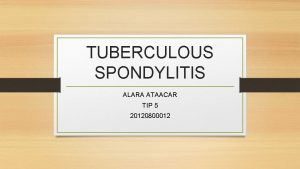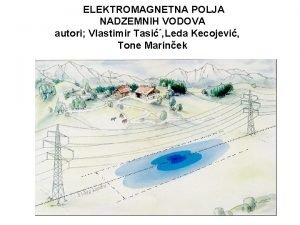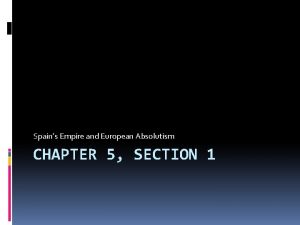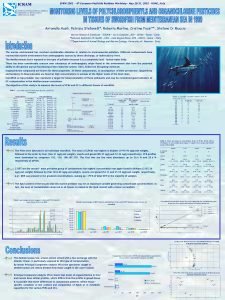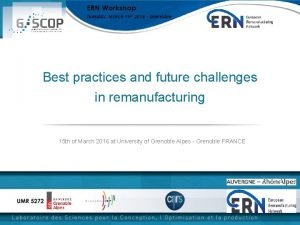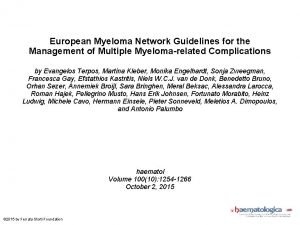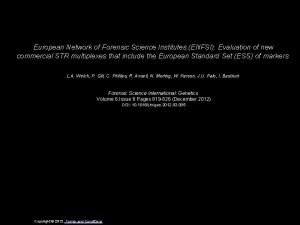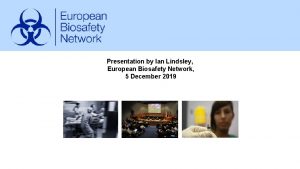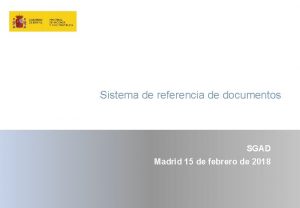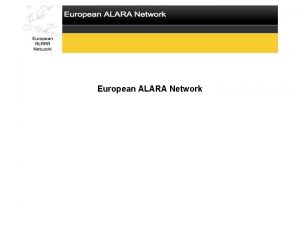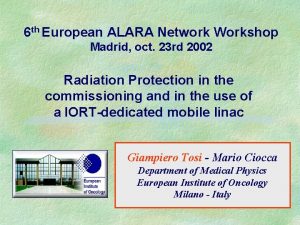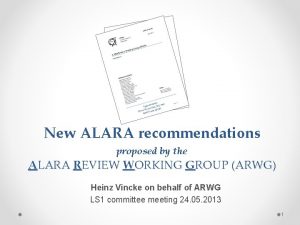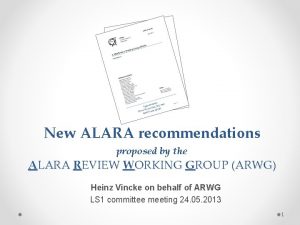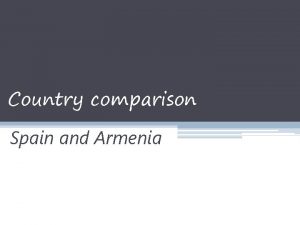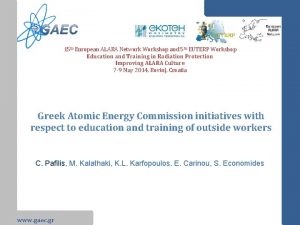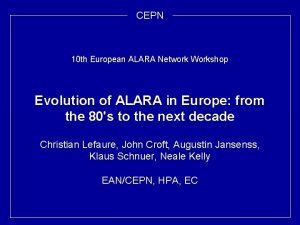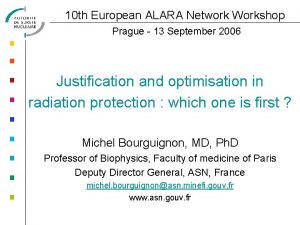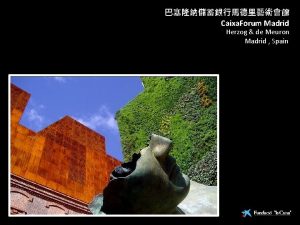6 th European ALARA Network Workshop Madrid Spain























- Slides: 23

6 th European ALARA Network Workshop Madrid, Spain, 23 -25 October 2002 Problems at the development of personal beta-particle dosemeters Klaus Helmstädter and Peter Ambrosi Physikalisch-Technische Bundesanstalt Braunschweig, Germany

Contents • Beta workplaces • Analysis of beta workplaces • Beta partial body dosemeter • PTB intercomparisons • Response of partial body dosemeters with TLD • Problems in practical operation of TL dosemeters • Electronic personal dosemeter • Area monitoring dosemeters • Conclusions

Beta workplaces Nuclear power plants: Contamination of surfaces and room air maximum beta energies from 0, 1 Me. V to 3, 5 Me. V Industrial applications: Production and use of radioactive sources maximum beta energies from 0, 1 Me. V to 3, 5 Me. V Example of use: Measurements of string and paper thickness Radiation therapy: Treatments of eye tumors Treatments of coronary arteries after a balloon dilatation (Intravascular Brachytherapy, IVB) Treatments of inflammatory joint deseases (Radiosynoviorthesis, RSO) maximum beta energies from 0, 1 Me. V to 3, 5 Me. V

Analysis of beta workplaces Exposures measured by Mielcarek and Barth: – Daily 1. 4 m. Sv in the production of eye applicators of the nuclide Ru-106/Rh-106 – More than 100 m. Sv in the preparation and use of radioactive solutions for IVB and RSO Conclusions drawn by Mielcarek and Barth: – Optimisation of radiation protection – Introduction of legal beta-particle dosemeter (partial body) – Training and information of the personnel – Exchange of experience

PTB intercomparisons PTB intercomparison in 1996: 10 TL-Dosemeters, compared for mean beta energies from 60 ke. V to 800 ke. V and different angles of incidence PTB intercomparison in 1998/1999: 5 selected TL-Dosemeters (TD 1 to TD 5), compared for mean beta energies from 60 ke. V to 800 ke. V, for mean photon energies from 8. 9 ke. V to 662 ke. V, for different angles of incidence and in mixed beta / photon fields

Beta partial body dosemeter (finger rings) TD 1 TD 3 TD 4 TD 5 TD 2

Response Hpt/HPTB for photon radiation

Pm 147 - ; Pm 147 1 m -1 ; 1 Sv Pm 47; 0 m /0° -1 10 Sv Pm 47; m. S /0° -1 10 v/4 47 m 5 ; 1 Sv ° 00 /6 K rm 0° 85 Sv K r- ; 1 8 m /0° K 5; r- 10 Sv/ 85 0 K ; 1 m. S ° r 85 0 m v/0 K ; 1 Sv ° r 85 0 m /45 ; 1 Sv ° Sr 00 /60 -9 m ° Sv Sr 0; -9 1 m /0° Sr 0; S -9 10 v/0 0 m ° Sr ; 1 S -9 0 m v/0 0 Sr ; 1 Sv ° -9 0 m /45 0; ° 10 Sv/ 0 60 m ° Sv /0 ° Pm Response Hpt/HPTB for beta radiation 2 1, 8 1, 6 1, 4 1, 2 H pt 1 H PTB 0, 8 0, 6 0, 4 0, 2 0 TD 1 TD 2 TD 3 TD 4 TD 5 LL UL

Response Hpt/HPTB for mixed beta/photon radiation

Problem with Pm-147 Inconsistent results in different intercomparisons 60° 45° 0°

Problems at practical operation of TLD – Non-uniformity of the TL material distribution inside the detector – Inhomogenity of the covering mylar foil – Thin TL material with high sensitivity required. – Thin TL material requires cautious handling. – Discrepancy between the wearing place and the position of maximum exposure – Standard photon rings are not suitable for beta measurements

Electronic personal dosemeter (EPD)

Electronic personal dosemeter (EPD) – Detector: semiconductor behind a thin entrance window – Measuring quantity: personal dose equivalent to the skin Hp(0. 07) (directional dose equivalent H´(0. 07)). – Response: acceptable compared to TLD detectors (Hp(0. 07)) and ionisation chambers (H´(0. 07)). – Drawback: Dosemeters are worn on the chest and cannot estimate the exposure of the finger tip.

Response Hpt/HPTB for beta radiation (EPD, TLD, IK)

Area dosemeters with ionisation chambers

Area dosemeters with szintillation detectors

Investigations on area dosemeters – Scintillation detectors are unsuitable for beta dose rate measurements also for Sr-90/Y-90. – Ionisation chambers with thin walls can measure acceptable beta dose rates even for low energy beta radiation. – The typically large measuring volume is a problem because of the decay of the dose rate within the detector. Therefore, measurements are only useful at distances greater than 50 cm from the source.

Problem: Detector size

Conclusions Suitable beta particle dosemeters (partial body) exist but they need to be improved with regards to: – Optimisation of detector cover thickness – Wearing comfort – Robustness and sterilisability – Acceptability to the personnel Area monitoring dosemeters should be developed with semiconductor detectors: – Small dimensions – High sensitivity Spectrometric and dosimetric analysis of workplaces is necessary to find the relation between the place of maximum exposure and the dosemeter wearing position.

Standard photon rings with TLD in beta fields Standard photon rings were calibrated in beta radiation fields of 85 Kr and 90 Sr/90 Y sources. The response decreases from about 1 for 90 Sr / 90 Y at 0° incidence to 0. 4 at 60° incidence and to 0. 2 for 85 Kr at all angle of incidence. High-energy beta fields are always accompanied by low-energy components behind the shielding which would be underestimated. For photon rings in beta fields the measurement value 0 therefore does not necessarily imply that there is no beta radiation at all. Especially behind the shielding, a significant contribution to the personal dose equivalent to the skin could be caused by low-energy beta radiation. Standard photon rings cannot be used for beta dose measurements

Standard photon rings with TLD in beta fields

Beta measurements with and without cap 1 Szintillation detectors 0, 1 M with M 0, 01 without Ionisation chambers 1 E-3 0 200 400 Mean beta energy 600 800 ke. V 1000

Technical data of beta-particle dosemeters (partial body)
 What is the relative location of spain
What is the relative location of spain Madrid spain museum statue
Madrid spain museum statue Alara dirik
Alara dirik Alara ataacar
Alara ataacar Alara şevket demirel ortaokulu
Alara şevket demirel ortaokulu Alara princip
Alara princip Alara facility management
Alara facility management Chapter 5 section 1 spain's empire and european absolutism
Chapter 5 section 1 spain's empire and european absolutism Chapter 5 section 1 spain's empire and european absolutism
Chapter 5 section 1 spain's empire and european absolutism Chapter 21 section 1 spain's empire and european absolutism
Chapter 21 section 1 spain's empire and european absolutism European pesticide residue workshop
European pesticide residue workshop Central european lung cancer patient network
Central european lung cancer patient network European vlbi network
European vlbi network European creative hubs network
European creative hubs network European remanufacturing network
European remanufacturing network European myeloma network
European myeloma network Business angels europe
Business angels europe European network of forensic science institutes
European network of forensic science institutes European biosafety network
European biosafety network Launch27 themes
Launch27 themes Wyd 2011 madrid
Wyd 2011 madrid Ano ang tunay na dahilan ng paglalakbay ni rizal sa europa
Ano ang tunay na dahilan ng paglalakbay ni rizal sa europa Sgad madrid
Sgad madrid Madrid goods and services manager
Madrid goods and services manager



